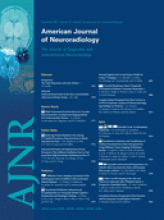Abstract
BACKGROUND AND PURPOSE: For patients with ICH, knowing the rate of CT contrast extravasation may provide insight into the pathophysiology of hematoma expansion. This study assessed whether the PCT-derived PS can measure different rates of CT contrast extravasation for admission CTA spot signs, PCCT, PCL, and regions without extravasation in patients with ICH.
MATERIALS AND METHODS: CT was performed at admission and at 24 hours for 16 patients with ICH with/without contrast extravasation seen on CTA and PCCT. PCT-PS was measured at admission. The Wilcoxon rank sum test with a Bonferroni correction was used to compare PS values from the following regions of interest: 1) spot sign lesions only (9 foci), 2) PCL lesions only (9 foci), 3) hematoma excluding extravasation, 4) regions contralateral to extravasation, 5) hematoma in patients without extravasation, and 6) an area contralateral to that in 5. Additionally, hematoma expansion was determined at 24 hours defined by NCCT.
RESULTS: PS was 6.5 ± 1.60 mL · min−1 × (100 g)−1, 0.95 ± 0.39 mL · min−1 × (100 g)−1, 0.12 ± 0.39 mL · min−1 × (100 g)−1, 0.26 ± 0.09 mL · min−1 × (100 g)−1, 0.38 ± 0.26 mL · min−1 × (100 g)−1, and 0.09 ± 0.32 mL · min−1 × (100 g)−1 for the following: 1) spot sign lesions only (9 foci), 2) PCL lesions only (9 foci), 3) hematoma excluding extravasation, 4) regions contralateral to extravasation, 5) hematoma in patients without extravasation, and 6) an area contralateral to that in 5. PS values from spot sign lesions and PCL lesions were significantly different from each other and all other regions, respectively (P < .05). Hematoma volume increased from 34.1 ± 41.0 mL to 40.2 ± 46.1 mL in extravasation-positive patients and decreased from 19.8 ± 31.8 mL to 17.4 ± 27.3 mL in extravasation-negative patients.
CONCLUSIONS: The PCT-PS parameter measures a higher rate of contrast extravasation for CTA spot sign lesions compared with PCL lesions and hematoma. Early extravasation was associated with hematoma expansion.
Abbreviations
- CBF
- cerebral blood flow
- CBV
- cerebral blood volume
- CTA
- CT angiography
- ICH
- intracerebral hemorrhage
- IVH
- intraventricular hemorrhage
- NCCT
- non-contrast CT
- NIHSS
- National Institutes of Health Stroke Scale
- PCCT
- post–contrast-enhanced CT
- PCL
- postcontrast leakage
- PCT
- perfusion CT
- PS
- permeability surface area product
- PWI
- perfusion-weighted imaging
- © 2011 by American Journal of Neuroradiology












